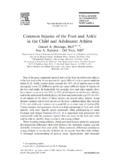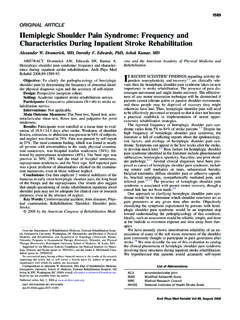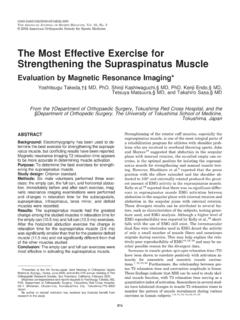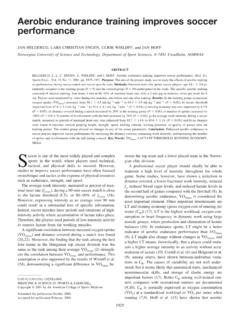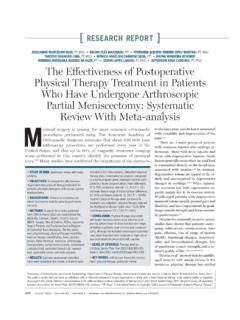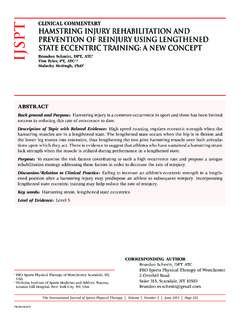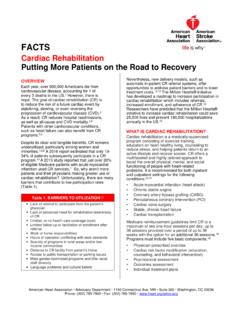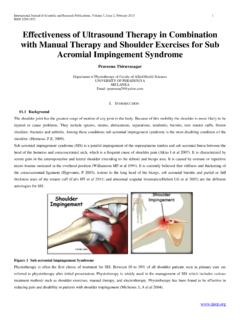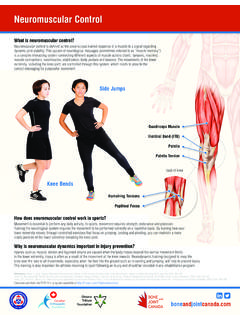Transcription of Clinical Examination of the Hip Joint in Athletes
1 3 Journal of Sport Rehabilitation, 2009, 18, 3-23 2009 Human Kinetics, Examination of the Hip Joint in AthletesBenjamin G. Domb, Adam G. Brooks, and J. W. ByrdIn recent years, a quantum leap has been made in the diagnosis and treatment of nonarthritic hip injuries. This evolution can be attributed in part to better imaging, improved understanding of the anatomy and biomechanics of the hip, and prog-ress in surgical technology and techniques. Among other advances, labral tears and early cartilage damage have been identified as common sources of pain. Fur-thermore, important etiologies for hip injury have been explained, including fem-oroacetabular impingement (FAI).1 These advances have led to a rapid increase in the correct diagnosis of nonarthritic hip with the advances in diagnosis, a revolution in surgical treatment of hip injuries is emerging.
2 Many Joint -preserving surgeries including labral deb-ridement or repair and decompression of impinging bone lesions can now be per-formed arthroscopically. These arthroscopic hip surgeries have provided new options with high Clinical success rates for patients with nonarthritic hip nonarthritic hip poses a diagnostic dilemma because pain is difficult to localize for both the patient and the clinician. As many as 60% of patients requir-ing hip arthroscopy are initially misdiagnosed, and in one study these patients remained misdiagnosed for an average of 7 With the new body of knowl-edge involving nonarthritic hip injuries, clinicians have a tremendous opportunity to help such patients arrive at a diagnosis and be successfully treated. A thorough history and physical are extremely important in determining hip pathology, which is exceptionally relevant given current innovations in therapy for hip pathology.
3 Although the hip is frequently overlooked as the original source of pain or pathol-ogy, one study demonstrated that Clinical assessment can be 98% reliable in detecting the presence of a hip- Joint Examination of the hip region can be complex, however, because of coexistent pathology, secondary dysfunction, or coincidental findings. For example, hip- Joint disease might coexist with lumbar-spine disease. Disorders of the paravertebral muscles can cause soft-tissue insta-bility and irregular tension on the hip,5 and contractures of the iliopsoas and ham-strings can cause back In addition, hip pathology might coexist with athletic pubalgia, especially in male Athletes . Symptoms of athletic pubalgia require a systematic and reproducible physical Examination of the hip with appropriate Domb is with Loyola University Chicago.
4 Brooks is with the Keck School of Medicine, University of Southern California. Byrd is with the Nashville Sports Medicine and Orthopaedic Center, Dept of Orthopaedics and Domb, Brooks, and Byrdimaging and diagnostic tests to distinguish pubalgia from intra-articular hip disorders often remain undetected for protracted periods of time. In the course of compensating for their symptoms, patients often develop secondary dysfunction. This chronic pathology can lead to symptoms of trochanteric bursitis or chronic gluteal discomfort. The Examination findings for the secondary disor-ders might be more evident and mask the underlying problem with the hip. In addition, there might also be coincidental findings unrelated to disorders of the hip. Snapping of the iliopsoas tendon and iliotibial band is usually an incidental finding without Clinical significance, but this snapping can become a source of symptoms or might exist coincidentally with hip- Joint structures can create similar or overlapping symptoms.
5 In addition to the Joint , the clinician must be cognizant of bone problems, surrounding muscu-lotendinous and bursal structures, circulatory pathology, neurological disorders including numerous small sensory nerves, and even visceral disorders that can refer symptoms to the hip area. To separate these problems this article will detail appropriate evaluation of the hip by history and physical exam, which will consist of inspection, measurements, symptom localization, and muscle-strength and spe-cial detailed history of the hip should include the patient s age, the chief complaint, and the presence or absence of trauma, as well as any treatments the patient has already used, such as nonsteroidal anti-inflammatory drugs, physical therapy, or assistive In addition, a past medical history of hip disorders or disloca-tions during birth or infancy, past surgeries, or major illnesses should be noted along with a family history of hip dislocations or disorders, degenerative Joint disease, rheumatological disorders.
6 Or various disorders can manifest as hip pain, the history might be equally varied with regard to onset, duration, and severity of symptoms. Acute labral tears associated with an injury often remain undiagnosed for decades and can present as chronic disorders, and patients with a degenerative labral tear might describe the acute onset of symptoms associated with a relatively innocuous epi-sode and gradual progression of symptoms. Because back and hip pain often coexist, care should be taken to note the relative severity of each type of pain. In addition, weakness, numbness, or paresthesia in the lower extremity suggests neural compression, which often occurs in the lumbar general, a positive history of significant trauma is a good prognostic indi-cator of a potentially correctable Insidious onset of symptoms is a poorer prognostic indicator and suggests either underlying degenerative disease or some predisposition to injury.
7 Patients might recount a minor precipitating epi-sode such as a twisting injury, but even under such circumstances, there might be an underlying susceptibility to Joint damage with a less certain prognosis. With any hip- Joint problem, the clinician must look closely for predisposing factors. For example, FAI is a recognized cause of Joint breakdown in young Mechanical symptoms such as locking, catching, popping, or sharp stabbing pain are also better prognostic indicators of a correctable problem, whereas pain in the Clinical Examination of the Hip 5absence of mechanical symptoms is a poorer The presence of a pop or click during Examination of the hip is an ambiguous finding at best, however, one that is often not proportionally related to the hip pathology. Although these sounds might suggest an unstable lesion inside the Joint , many painful intra- articular problems never demonstrate this finding, and popping and clicking can occur from extra-articular causes, most of which are are characteristic features of the history that often suggest a mechani-cal hip problem.
8 Symptoms worse with activities Twisting, such as turning, changing directions Seated position might be uncomfortable, especially with hip flexion Rising from seated position often painful (catching) Difficulty ascending and descending stairs Symptoms with entering and exiting an automobile Dyspareunia (painful sexual intercourse) Difficulty with shoes, socks, hose, and so on10 These characteristics are helpful in localizing the hip as the source of trouble but are not specific for the type of pathology. Pain is usually worse with activities with a mechanical problem. Straight-plane activities such as straight-ahead walking or even running are often well tolerated, whereas twisting maneuvers such as simply turning to change direction might produce sharp pain, especially turning toward the symptomatic side, which places the hip in internal rotation.
9 Sitting for pro-longed periods might be uncomfortable, especially if the hip is placed in excessive flexion. Rising from the seated position might be especially painful and the patient might experience an accompanying catch or sharp stabbing sensation. Symptoms are worse with ascending or descending stairs or other inclines. Entering and exit-ing an automobile are often difficult with accompanying pain because the hip is loaded in a flexed position along with twisting maneuvers. Dyspareunia is often an issue because of hip- Joint pain. This is more commonly a problem for women but can be a difficulty for men, as well. Difficulty with shoes, socks, or hose might simply be caused by pain or might reflect restricted rotational motion and more advanced hip- Joint and most important, the examiner should be sure to note any red flags during the history, such as fever, malaise, night sweats, weight loss, night pain, intravenous drug use, cancer history, or known immunocompromised state, which can indicate systemic problems that necessitate further diagnostic Based on the information obtained in the history, a preliminary differential diag-nosis should be formulated.
10 The history helps the examiner perform an appropri-ately directed physical ExaminationAlthough the information obtained in the history is a screening tool and helps direct the Examination , it should not unduly prejudice the approach. The examiner must be systematic and thorough to avoid potential pitfalls and missed diagnoses. 6 Domb, Brooks, and ByrdIn reference to Examination of the hip, the famous orthopedic surgeon Otto Aufranc noted that more is missed by not looking than by not knowing. 12 InspectionThe most important aspects of inspection are stance and gait. The patient s posture is observed in both the standing and the seated position. Any splinting or protec-tive maneuvers used to alleviate stresses on the hip Joint are noted. In the standing position, the examiner might appreciate a slightly flexed position of the involved hip and concomitantly the ipsilateral knee (Figure 1).
